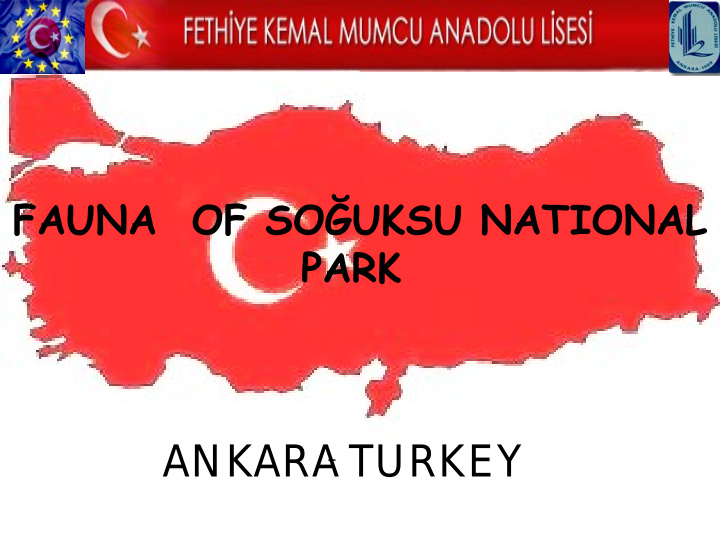



FAUNA OF SOĞUKSU NATIONAL PARK ANKARA – TURKEY
Among the wildlife that is found in the national park are wild boars, bears, foxes, jackals, squirrels and rabbits as well as over 35 species of birds. Nearby the Park is a Partridge and Chukar Partridge breeding station. Other species that are found in the station are buzzards, pheasants, quails and pigeons.
Aegypius monachus (Kara akbaba - Cinereous vulture) Cinereous vulture is the biggest vulture in Europe. It breeds in high mountains and large forests, nesting in trees or occasionally on cliff ledges. The cinereous vulture feeds on carrion ranging from large mammals to fish and reptiles. In Europe, populations are increasing in Spain. However, numbers are decreasing in Turkey, Armenia, Azerbaijan, Georgia, Russia and Ukraine. It qualifies as Near Threatened in red data book of Turkey.
Gyps fulvus (Kızıl Akbaba Griffon Vulture) It is a native animal in Turkey according to red data book The griffon vulture is a scavenger, feeding mostly from carcasses of dead animals which it finds by soaring over open areas, often moving in flocks. It is a typical Old World vulture in appearance, with a very white head, very broad wings and short tail feathers. It has a white neck ruff . The population is mostly resident.
Phasianus colchicus (Bayağı sülün - Common Pheasant) This species has an extremely large range, and hence does not approach the thresholds for Vulnerable under the range size criterion. The species is evaluated as Least Concern in red data book. Pheasant is one of the world's most hunted birds. There are many colour forms of the male Common Pheasant, ranging in colour from nearly white to almost black in some melanistic examples.
Ursus Arctos (Boz Ayı - Brown Bear) The brown bear is the most widely distributed of all bears.While the brown bear's range has shrunk and it has faced local extinctions. It remains listed as a least concern species by the IUCN with a total population of approximately 200,000.. Globally the population remains large, and is not significantly declining. There are many small, isolated populations that are in jeopardy of extirpation, but others, under more protection, are expanding.
Canis aureus (Altın Çakal - Golden Jackal) The golden jackal is very similar to the wolf in general appearance, but is much smaller in size and lighter in weight, and has shorter legs, a more elongated torso and a shorter tail. They are opportunistic and will venture into human habitation at night to feed on garbage.
invasive species". among the "world's 100 worst extinction by the IUCN. It is listed It is listed as Least Concern for The red fox is the largest of the true foxes, as well as being the most geographically spread member of the Carnivora. The red fox is distinguished from other fox species by its ability to adapt quickly to new environments and, unlike most of its cousins, is not listed as Endangered anywhere. (Kızıl tilki - Red Fox) Vulpes vulpes
Cervus elephus (Kızıl geyik - Red deer) The red deer that lives in Soğuksu National Park is the largest member of the deer family known from the fossil record one of the largest deer species. Red deer are ruminants, characterized by an even number of toes, and a four- chambered stomach.
Sus scrofa (Yaban domuzu - Wild Boar) Wild boar is the wild ancestor of the domestic pig, an animal with which it freely hybridises.The body of the wild boar is compact; the head is large, the legs relatively short. The fur consists of stiff bristles and usually finer fur. The colour usually varies from dark grey to black or brown, but there are great regional differences in colour.
Lepus eureopaeus (Bayağı tavşan - European Hare) Hares primarily live in open fields and pasture usually near agricultural areas and bordered by hedgerows and woodlots.It breeds on the ground rather than in a burrow and relies on speed to escape. The ears of the European hare are greyish white inside and have black tips on the top ends. Most of the hare’s body is covered in yellowish- brown to greyish-brown fur but has greyish-white fur on the underside.
Siurus anomalus (Anadolu Sincabı - Anatolian Squirrel) It ıs natıve in Turkey. In Turkey, it is not under serious threat at present. Its natural habitat is temperate broadleaf and mixed forests. They live in old woodpecker nests. Its enemies are foxs, cats, stoats, owls and falcons.
ALL AND MORE IS IN SOĞUKSU NATIONAL PARK THANKS. ANKARA – TURKEY
Recommend
More recommend